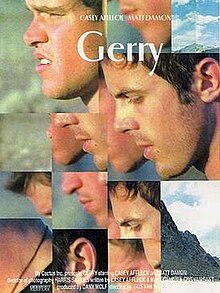| Gerry | |
|---|---|
 Film poster | |
| Directed by | Gus Van Sant |
| Written by |
|
| Produced by | Dany Wolf |
| Starring |
|
| Cinematography | Harris Savides |
| Edited by |
|
| Music by | Arvo Pärt |
| Distributed by | THINKFilm |
Release dates |
|
Running time | 103 minutes |
| Country | United States |
| Language | English |
| Budget | $3.5 million |
| Box office | $254,683 |
Gerry is a 2002 American drama film written and directed by Gus Van Sant, and starring and co-written by Matt Damon and Casey Affleck. It is the first installment of Van Sant's "Death Trilogy", three films based on deaths that occurred in real life and is succeeded by Elephant (2003) and Last Days (2005).
Gerry follows two hiking companions who both go by the name "Gerry". "Gerry" is also a slang term, used by both protagonists throughout the misadventure, meaning "to screw up".[1] Van Sant revealed in interviews that Damon, Affleck, and his brother Ben had already coined the term prior to the title being chosen.[1]
The plot shares some commonalities with the events surrounding the death of David Coughlin, who was killed after he and a friend became lost in Rattlesnake Canyon in New Mexico. The style was largely inspired by the work of Hungarian filmmaker Béla Tarr, namely its use of extended scenes playing out in uncut master shots. There are a few direct visual quotations from Tarr's Sátántangó (1994), such as a shot following the two protagonists while tumbleweeds blow around them that mimics a shot in Tarr's film where two men walk through a town as a windstorm blows around leaves and trash.
Besides the work of Tarr, the video game Tomb Raider was cited as an influence on the style. Van Sant had mentioned that he had not had much experience with video games and was struck by the fact that the lack of the ability to cut away from the action in video games meant having to stay with the characters during travel that would normally be glossed over in films. In an interview with Filmmaker Magazine, Van Sant stated "In some ways, Gerry is Béla Tarr fused with Tomb Raider!"[2]
Gerry is frequently cited as an example of non-narrative cinema.
- ^ a b Peary, Gerald (February 27, 2003). "Gerry meandering". The Phoenix. Archived from the original on February 27, 2006. Retrieved September 27, 2006.
- ^ Macaulay, Scott. "Sands of Time". Filmmaker Magazine. Retrieved 8 February 2016.